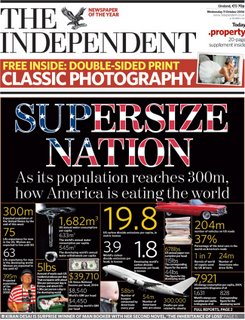EL presente artículo habla de la nación SUPERSIZE
US que come más de lo que necesita...avaricia...pecado capital!, no son tan puristas...yo no hago campaña contra US sólo, sino contra los Energyeaters!. Así USA, UK, Japón, etc...España estamos por ahí.
Espero que os parezca interesante.
US population hits 300 million, but is it sustainable?
By Andrew Buncombe in Washington
Published: 11 October 2006
The population of the United States will pass 300 million today, or tomorrow. No one knows exactly where, no one know precisely when. It is a milestone for sure but is this a cause for celebration or anxiety?
Some American commentators are already saying the landmark is a chance to note the US is perhaps the only country in the developed world where the economy is being bolstered by a population that is growing at a discernable rate. But many experts say passing the 300 million milestone should be a wake-up call that demands a reappraisal of the extraordinary, unparalleled rate of consumption by the world's largest economy and its third largest by population.
As an economic model for the rest of the world to follow - in particular the rapidly developing economies of China and India - it is unsustainable, they say.
On a global scale the average US citizen uses far more than his or her fair share of the planet's resources - consuming more than four times the worldwide average of energy, almost three times as much water and producing more than twice the average amount of rubbish and five times the amount of carbon dioxide, a major contributor to global warming. The US - with five per cent of the world's population - uses 23 per cent of its energy, 15 per cent of its meat and 28 per cent of its paper. Additional population will mean more people seeking a share of those often-limited resources.
It may be that America's citizen number 300,000,000 will be an undocumented migrant, born to undocumented parents somewhere in the South or the West, where population growth is the fastest. Almost one-third of America's annual population growth of between 0.9 per cent and 1 per cent is the result of immigration - much of it illegal.
"America is the only industrialised nation in the world experiencing significant population growth," Victoria Markham, the director of the Centre for Environment and Population (CEP), says in a new report. "The nation's relatively high rates of population growth, natural resource consumption and pollution combine to create the largest environmental impact, felt both within the nation and around the world." She adds: "
The US has become a 'super-size' nation, with lifestyles reflected in super-sized appetites for food, houses, land and resource consumption. 'More of more' seems to characterise modern-day America - more people than any generation before us experienced, more natural resources being utilised to support everyday life and more major impacts on the natural systems that support life on earth."
Some commentators believe this growth has a modest impact on the nation's resources and can bring many benefits. Greg Easterbrook, a fellow at the Brookings Institution, a Washington-based, independent research and policy institute, recently wrote: "What should not worry us about continuing US population growth ... is the question of whether we can handle it - we can," he said.
Lester Brown, the director of the Earth Policy Institute, an environmental group also based in Washington, said: "In times past, reaching such a demographic milestone might have been a cause for celebration - in 2006 it is not. Population growth is the ever-expanding denominator that gives each person a shrinking share of the resource pie. It contributes to water shortages, cropland conversion to non-farm uses, traffic congestion, more garbage, overfishing, crowding in national parks, a growing dependence on imported oil and other conditions that diminish the quality of our daily lives."
Mr Brown said there was also a global perspective to America's rapacious model of consumption. In addition to foreign policy decisions at least influenced by a desire to secure diminishing resources, he said the US was setting an example to the developing world that was unsustainable. "We used to think of the developing countries as places that did not consume very much ... But it is starting to change and they are beginning to behave like us and heading for income levels like us," he said.
If China's economy continued to grow at 8 per cent a year, Mr Brown said, income levels in that country would equal the 2004 US level by 2031, by which time China's population would stand at 1.45 billion.
If current consumption rates were multiplied to take into account its population growth, China's paper consumption would be double the current total world production of paper and its vehicle fleet would be 1.1 billion; the world's current total fleet is 800 million.
"What China is teaching us is that the Western economic model is not going to work for China and if it will not work for China it will not work for India and in the long-term ... it will not work for us as well," he said.
It was in 1915 that the US population reached 100 million. Fifty-two years later, in 1967, it reached 200 million. It has taken just 39 more years for the milestone of 300 million to be achieved.
1915: US population reaches 100 million
The population of America hit the 100-million mark in 1915, two years before President Woodrow Wilson would enter the First World War. Americans were stunned by the sinking of the British liner, 'Lusitania', enthralled by Charlie Chaplin and arguing about immigration. "There is here a great melting pot in which we must compound a precious metal," said Wilson, as a million European immigrants poured into the US each year.
The 'great white hope' Jess Willard beat black boxing champion Jack Johnson in a dubious bout in Havana; Marines were dispatched to Haiti after a mob killed its president and the Ku Klux Klan was reestablished as a 'benevolent' organisation.
1967: US passes 200 million
By 1967, when the US population hit 200m, the US was up to its neck in the Vietnam War, Muhammad Ali was stripped of his world heavyweight title for refusing the draft, dozens were killed in race riots in Detroit, and San Francisco was beguiled by the Summer of Love.
Eugene McCarthy said he would run for president, the 25th Amendment to the Constitution was passed allowing for a transfer of power to the vice-president if the president was incapacitated and three Apollo astronauts burned to death during a simulation at Cape Canaveral. The millionth telephone was installed in the US. Hit films included The Graduate, In the Heat of the Night and Bonnie and Clyde.
Supersize nation: how America is eating the world
300m Expected population of the United States by the end of this week
75 Life expectancy for men in the US. Women are expected to live until 80
63 Life expectancy for men in the developing world. Women are expected to live until 67
395m Projected population of the US by 2050
1,682m3 US annual water consumption per capita
633m3 The world's annual water consumption per capita
545m3 The developing world's annual water withdrawals per capita
5lbs Amount of waste each US resident produces per day. That compares with about 3lbs per person per day in Europe, and about 0.9-1.3lbs per person a day in the developing world
$39,710 US Gross National Income per head, 2004
$8,540 World's GNI per head
$4,450 Developing world's GNI per head
19.8 US carbon dioxide emissions per capita, in metric tonnes
3.9 World's carbon dioxide emissions per head, in tonnes
1.8 Developing world's carbon dioxide emissions per head, in tonnes
58bn Number of burgers consumed by Americans every year
54m Number of Americans who are obese
300,000 Deaths per year related to obesity
678lbs US annual paper consumption per head
115lbs The corresponding figure for the world
44lbs The figure for the developing world
204m number of vehicles on US roads
37% Percentage of the total cars in the world on America's roads
1 in 7 Barrels of world oil supply used by US drivers
24m Number of Americans who drive SUVs
7,921 US energy consumption per capita, 2001, expressed in kilograms of oil
1,631 World's energy consumption per capita, in kilograms of oil
828 Corresponding figure for the developing world
The population of the United States will pass 300 million today, or tomorrow. No one knows exactly where, no one know precisely when. It is a milestone for sure but is this a cause for celebration or anxiety?
Some American commentators are already saying the landmark is a chance to note the US is perhaps the only country in the developed world where the economy is being bolstered by a population that is growing at a discernable rate. But many experts say passing the 300 million milestone should be a wake-up call that demands a reappraisal of the extraordinary, unparalleled rate of consumption by the world's largest economy and its third largest by population.
As an economic model for the rest of the world to follow - in particular the rapidly developing economies of China and India - it is unsustainable, they say.
On a global scale the average US citizen uses far more than his or her fair share of the planet's resources - consuming more than four times the worldwide average of energy, almost three times as much water and producing more than twice the average amount of rubbish and five times the amount of carbon dioxide, a major contributor to global warming. The US - with five per cent of the world's population - uses 23 per cent of its energy, 15 per cent of its meat and 28 per cent of its paper. Additional population will mean more people seeking a share of those often-limited resources.
It may be that America's citizen number 300,000,000 will be an undocumented migrant, born to undocumented parents somewhere in the South or the West, where population growth is the fastest. Almost one-third of America's annual population growth of between 0.9 per cent and 1 per cent is the result of immigration - much of it illegal.
"America is the only industrialised nation in the world experiencing significant population growth," Victoria Markham, the director of the Centre for Environment and Population (CEP), says in a new report. "The nation's relatively high rates of population growth, natural resource consumption and pollution combine to create the largest environmental impact, felt both within the nation and around the world." She adds: " The US has become a 'super-size' nation, with lifestyles reflected in super-sized appetites for food, houses, land and resource consumption. 'More of more' seems to characterise modern-day America - more people than any generation before us experienced, more natural resources being utilised to support everyday life and more major impacts on the natural systems that support life on earth."
Some commentators believe this growth has a modest impact on the nation's resources and can bring many benefits. Greg Easterbrook, a fellow at the Brookings Institution, a Washington-based, independent research and policy institute, recently wrote: "What should not worry us about continuing US population growth ... is the question of whether we can handle it - we can," he said.
Lester Brown, the director of the Earth Policy Institute, an environmental group also based in Washington, said: "In times past, reaching such a demographic milestone might have been a cause for celebration - in 2006 it is not. Population growth is the ever-expanding denominator that gives each person a shrinking share of the resource pie. It contributes to water shortages, cropland conversion to non-farm uses, traffic congestion, more garbage, overfishing, crowding in national parks, a growing dependence on imported oil and other conditions that diminish the quality of our daily lives."
Mr Brown said there was also a global perspective to America's rapacious model of consumption. In addition to foreign policy decisions at least influenced by a desire to secure diminishing resources, he said the US was setting an example to the developing world that was unsustainable. "We used to think of the developing countries as places that did not consume very much ... But it is starting to change and they are beginning to behave like us and heading for income levels like us," he said.
If China's economy continued to grow at 8 per cent a year, Mr Brown said, income levels in that country would equal the 2004 US level by 2031, by which time China's population would stand at 1.45 billion.
If current consumption rates were multiplied to take into account its population growth, China's paper consumption would be double the current total world production of paper and its vehicle fleet would be 1.1 billion; the world's current total fleet is 800 million.
"What China is teaching us is that the Western economic model is not going to work for China and if it will not work for China it will not work for India and in the long-term ... it will not work for us as well," he said.
It was in 1915 that the US population reached 100 million. Fifty-two years later, in 1967, it reached 200 million. It has taken just 39 more years for the milestone of 300 million to be achieved.
1915: US population reaches 100 million
The population of America hit the 100-million mark in 1915, two years before President Woodrow Wilson would enter the First World War. Americans were stunned by the sinking of the British liner, 'Lusitania', enthralled by Charlie Chaplin and arguing about immigration. "There is here a great melting pot in which we must compound a precious metal," said Wilson, as a million European immigrants poured into the US each year.
The 'great white hope' Jess Willard beat black boxing champion Jack Johnson in a dubious bout in Havana; Marines were dispatched to Haiti after a mob killed its president and the Ku Klux Klan was reestablished as a 'benevolent' organisation.
1967: US passes 200 million
By 1967, when the US population hit 200m, the US was up to its neck in the Vietnam War, Muhammad Ali was stripped of his world heavyweight title for refusing the draft, dozens were killed in race riots in Detroit, and San Francisco was beguiled by the Summer of Love.
Eugene McCarthy said he would run for president, the 25th Amendment to the Constitution was passed allowing for a transfer of power to the vice-president if the president was incapacitated and three Apollo astronauts burned to death during a simulation at Cape Canaveral. The millionth telephone was installed in the US. Hit films included The Graduate, In the Heat of the Night and Bonnie and Clyde.
Supersize nation: how America is eating the world
300m Expected population of the United States by the end of this week
75 Life expectancy for men in the US. Women are expected to live until 80
63 Life expectancy for men in the developing world. Women are expected to live until 67
395m Projected population of the US by 2050
1,682m3 US annual water consumption per capita
633m3 The world's annual water consumption per capita
545m3 The developing world's annual water withdrawals per capita
5lbs Amount of waste each US resident produces per day. That compares with about 3lbs per person per day in Europe, and about 0.9-1.3lbs per person a day in the developing world
$39,710 US Gross National Income per head, 2004
$8,540 World's GNI per head
$4,450 Developing world's GNI per head
19.8 US carbon dioxide emissions per capita, in metric tonnes
3.9 World's carbon dioxide emissions per head, in tonnes
1.8 Developing world's carbon dioxide emissions per head, in tonnes
58bn Number of burgers consumed by Americans every year
54m Number of Americans who are obese
300,000 Deaths per year related to obesity
678lbs US annual paper consumption per head
115lbs The corresponding figure for the world
44lbs The figure for the developing world
204m number of vehicles on US roads
37% Percentage of the total cars in the world on America's roads
1 in 7 Barrels of world oil supply used by US drivers
24m Number of Americans who drive SUVs
7,921 US energy consumption per capita, 2001, expressed in kilograms of oil
1,631 World's energy consumption per capita, in kilograms of oil
828 Corresponding figure for the developing world









